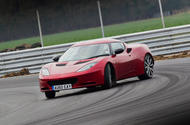It rode and handled in a way that put nearly everything else in its shade, and it’s yours from £20k
The Lotus Evora arrived in 2011 as an answer to the practical problems created by the admirable, but much smaller Lotus Elise.The Evora’s younger brother might have had pure and animal-like intercommunication between car and driver, but it wasn’t much cop if you wanted to travel further than the local pub or if you had to take your children to school.Enter, stage left, the Evora – a 2+2 coupé with all the swagger and a three-section composite body (with easily replaceable plastic bumpers) but with a token nod towards comfort and touring.Launched in 2009, it seemed to be the answer to either numerous prayers or the question no one posed. Naturally, it is not a Mercedes S-Class rival.Peak behind the welcoming front seats and you will see an extra pair of rather teeny rear seats, such as only the very young, impressively flexible and eternally optimistic would want to explore. (Which is why some Evoras were also sold without +2 seating.) The whole thing is powered by an eager, all-alloy and transversely mounted 3456cc V6, admittedly also found in a Toyota Camry and a Lexus RX 350 once upon a time, but here with a bespoke Lotus electronic throttle map, making it good for 276bhp at 6400rpm. That’s enough to give the 1382kg Lotus performance in the order of a 162mph top speed and 0-60mph in just 5.4sec.Faster versions followed, including the S, the 400, the Sport 410, a GT410 Sport and a GT430, the last with a top speed just shy of the 200mph mark.But, look, a Lotus – any Lotus – is about more than just comfort and straight-line speed. It’s about handling finesse, and here the Evora excelled.It’s one of those rare and wonderful cars that is happy to corner in whichever way its driver wants it to.The steering has a lovely linear feel with perfect weighting, not an ounce too heavy and not too light. Without excess provocation, the Evora will grip soundly until its front wheels start to slip.It can be provoked into a predictable, wonderfully forgiving slide. (There’s an electronic lock for the open differential.)Switching out the traction control’s intervention completely is the point from where the Evora’s chassis really shows its mettle. In our eyes, no other production car of the time handled as well as an Evora once beyond its limits.It rode well too, at least in its original form. In faster driving, the Evora maintains a supple ride across crests and bumps, with high levels of body control.Only the loose, vague gearshift of the early cars lets it down, which is the weakest part of an otherwise impressive performance inventory, but brings us to this car’s common problems.Lotus Evora 2011-2015 common problemsEngine: The chain-driven Toyota V6 is reliable but check the ECU for any record of over-revving. There have been some reported problems with the Edelbrock supercharger, albeit mostly in US cars.Check the engine has been serviced every year or 9000 miles and the exhaust mounts are sound (a warranty issue on early cars). Expect around 23mpg from the original Evora and the S in everyday use. Gearbox: On early cars, manual gearchange cables can stretch, become noisy and make changes difficult. Adjustment or replacement requires interior trim removal.Later cars solved the issue with better cables. The clutch can fail as early as 25,000 miles. Check that the IPS gearbox changes smoothly.Suspension and brakes: The Evora should steer, brake and ride like you would expect a Lotus to. Watch out for signs of track abuse. Uneven tyre wear could indicate misaligned tracking caused by a past crash. A knocking at the front is likely to be worn anti-roll bar bushes.Body: Check the panel gaps because any out-of-shape parts of the composite bodywork will be expensive to set right. Rust won’t be a problem, though.Door handles can give up the ghost. Tailgate panels can get dented by over-enthusiastic use. Bootlids and petrol filler caps can give trouble. Interior: Early cars were criticised for poor interior quality but this improved in later examples. Sat-nav has been criticised for its level of efficiency and response.Check for worn driver’s seat side bolsters, door speakers, lower fascia and fragile leather facings on sills.







